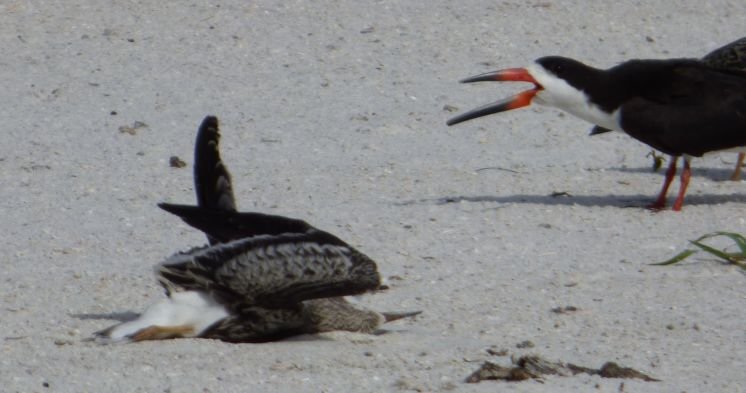
Volunteers who have been monitoring the mass die-off suspect the dumping of more than 1 million gallons of municipal sewage into Boca Ciega Bay has something to do with it.
"We fully expect more to die," said Lorraine Margeson of the Florida Shorebird Alliance, who found the first bird carcass on Aug. 12.
An Eckerd College scientist who has been studying the state's skimmer population for 16 years says that the affected young birds go into convulsions, then flop over on their backs and die.
"This is the first time I have ever seen anything like this in Florida," said Elizabeth Forys, a professor of environmental science and biology.
The cause of death could be salmonella, a virus or even Red Tide, Forys said. Each of those potential causes, she said, could be related to the dumping of sewage.
State wildlife officials are investigating and have sent samples from the dead skimmers to the University of Georgia College of Veterinary Medicine's Southeast Cooperative Wildlife Disease Study. The results from those tests, and from other tests being done by the state's own wildlife laboratory in St. Petersburg, said state wildlife commission spokeswoman Susan Smith, "are still pending."
Heavy rains in August prompted a number of Pinellas County cities to dump sewage into area waterways. Gulfport dumped 302,400 gallons into Boca Ciega Bay on Aug. 8.
Hurricane Hermine exacerbated the problem when its rains lashed the Florida peninsula earlier this month. An additional 892,500 gallons spilled Sept. 2, according to city public works director Don Sopak, which is when the storm made landfall in North Florida.
The sewage issue could worsen as the region grapples with the amount of waste that was spilled onto streets and waterways. St. Petersburg officials on Monday estimated that the city dumped about 70 million gallons of sewage into the waters of Tampa Bay. That brings the official total that local cities and counties dumped to 135.1 million gallons — a number that continues to rise.
Boca Ciega Bay has long suffered from poor flushing, caused by dredge-and-fill development in the 1950s and '60s. That means any sewage dumped into the bay is likely to stay there for a long time.
Skimmers are easily identified by their vivid red-and-black bills. A flying skimmer drags its knife-thin bill through the water, scooping up small fish to eat, then snapping its bill shut. One 1930s biologist compared them to "aerial beagles hot on the scent of aerial rabbits."
Black skimmers are currently classified as a species of special concern in Florida, but state officials are leaning toward raising that level of protection to threatened, according to Forys.
Because they're an imperiled species, and Pinellas County supports about 30 percent of the 2,000 breeding pairs of skimmers that remain in Florida, volunteers from the Florida Shorebird Alliance have been going out daily to monitor their nesting. The colonies in the rest of the county appear to be all right, Forys said.
Margeson documented the first dead juvenile last month near Barnacle Bill's seafood restaurant in St. Pete Beach. A day later, Forys watched one die. She said she saw it "dragging its wings, then looked to have convulsions and flipped onto its back."
That St. Pete Beach colony started out with 115 fledglings, and since Margeson's discovery, they have found between one and six dead every day, Forys said.
It's possible that more than 45 have died, but the bodies weren't found or were disposed of before the volunteers could get to them, Margeson said.



Reader Comments
to our Newsletter